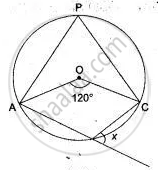Advertisements
Advertisements
Question
In the figure alongside PR is a diameter of the circle, PQ = 7 cm; QR = 6 cm and RS = 2 cm. Calculate the perimeter of the cyclic quadrilateral PQRS.
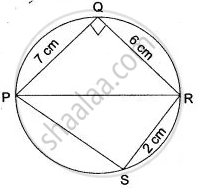
Solution
PR is the diameter of the circle.
then ∠ PQR = 90° .....(Angle in semicircle)
In Δ PQR,
PR = `sqrt((7)^2 + (6)^2)`
PR = `sqrt(49 + 36)`
PR = `sqrt(85)`
Similarly,
∠ PSR = 90°
In ΔPSR,
PS = `sqrt("PR"^2 - "SR"^2)`
PS = `sqrt(85 - 4)`
PS = `sqrt(81)`
PS = 9 cm
Perimeter of cyclic quadrilateral PQRS = PQ + QR + RS + PS
Perimeter of cyclic quadrilateral PQRS = 7 cm + 6 cm + 2 cm + 9 cm = 24 cm
Perimeter of cyclic quadrilateral PQRS = 24 cm.
APPEARS IN
RELATED QUESTIONS
In the figure, ABCD is a cyclic quadrilateral with BC = CD. TC is tangent to the circle at point C and DC is produced to point G. If ∠BCG = 108° and O is the centre of the circle, find :
- angle BCT
- angle DOC

The quadrilateral formed by angle bisectors of a cyclic quadrilateral is also cyclic. Prove it.
In the given figure, ABCD is a cyclic quadrilateral. AF is drawn parallel to CB and DA is produced to point E. If ∠ADC = 92°, ∠FAE = 20°; determine ∠BCD. Give reason in support of your answer.

In triangle ABC, AB = AC. A circle passing through B and c intersects the sides AB and AC at D and E respectively. Prove that DE || BC.
In cyclic quadrilateral ABCD, ∠DAC = 27°; ∠DBA = 50° and ∠ADB = 33°. Calculate : ∠CAB.
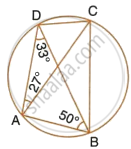
In the following figure, Prove that AD is parallel to FE.

In the figure, ∠DBC = 58°. BD is a diameter of the circle. Calculate : ∠BEC
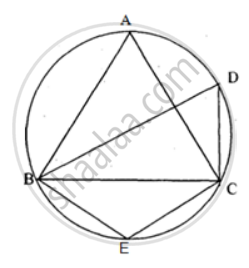
The diagonals of a cyclic quadrilateral are at right angles. Prove that the perpendicular from the point of their intersection on any side when produced backward bisects the opposite side.
In the adjoining figure, AB is the diameter of the circle with centre O. If ∠BCD = 120°, calculate:
(i) ∠BAD (ii) ∠DBA
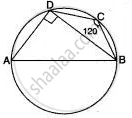
If O is the centre of the circle, find the value of x in each of the following figures
